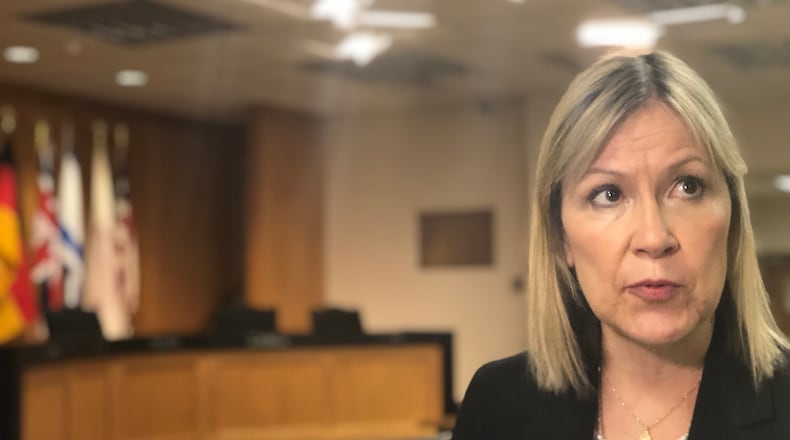Dayton plans to use more than $4.7 million of its cash reserves and it expects to keep a reduced payroll after it put through voluntary buyouts and position eliminations this year.
“You add these all together, we had to come up with $19.4 million worth of solutions to balance the budget,” said Diane Shannon, Dayton’s director of procurement, management and budget.
She said, ““These (budget actions) will significantly impact the delivery of critical front line services in 2021.”
City officials are still lobbying for federal aid, because the city administration says it wants help to maintain service levels and make investments in the community.
“This has probably been one of the most difficult periods of time in the last century,” said Dayton City Manager Shelley Dickstein. “We absolutely need additional federal resources …”
Dayton’s final estimated 2020 general fund budget is expected to be about $179.8 million ― down from an original estimate of $182.7 million, according to city data. This does not include a 27th pay period — something that occurs every few years based on how many pay periods fall in the 12 months.
This year’s projected final budget is down $6.3 million — or 3.4 percent — from 2019 spending.
The city administration says COVID-19 took a toll on the city’s finances. General fund revenues saw strong growth in the first quarter of 2020, before collapsing after stay-at-home orders, lockdown measures and other disruptions caused by the pandemic.
Dickstein’s 2021 recommended general fund budget projects the city will receive $171.6 million in revenue ― down about $14.5 million from the recent peak in 2019.
The city expects to use $4.75 million of its cash reserves, meaning total expenses will be $176.3 million.
The city last dipped into its cash reserves in 2014, using $1.7 million.
The city has not budgeted a fire or police recruit class next year, officials said.
This will be the first time the police department had no recruit class since 2011, a police spokesperson said.
The city went three years (2009-11) without a class because of federal litigation over the civil service written exam. Police staffing dropped sharply during that time.
Postponing the next police recruit class until January of 2022 is expected to save about $800,000, Shannon said.
The city will need a very large class to meet a commitment city leaders made when campaigning to pass the Issue 9 tax income tax hike. The city pledged to have an average of 365 sworn officers by 2022, she said. Voters passed Issue 9 in 2016, increasing the city’s income tax rate .25-percent to a total of 2.5 percent in return for pledges of road resurfacing and other improvements of city services.
The recommended budget pushes back the 2021 fire academy from January until August, in the hopes the fire department will receive a federal grant to cover the associated costs, officials said. That move is expected to save the city about $1 million.
Dayton’s staffing levels are down significantly from pre-pandemic levels, officials say.
About 102 city employees opted to participate in a voluntary separation plan this year, and 100 budgeted vacant positions were eliminated, saving the city about $3.8 million, Shannon said.
About one-quarter of the positions that were cut were added back because they were too important to leave unfilled, Shannon said.
City officials say the current budgeted staffing levels are insufficient to maintain the level of service the public has come to expect.
The city plans to reduce its spending on capital projects, equipment and development assistance by more than $2.25 million (or $750,000 for each category).
The city typically budgets $2.75 million both for capital equipment and projects and $3 million for development support.
The city plans to implement two health insurance holidays ($2.7 million savings) — a step which uses accrued savings in the city’s health insurance fund from 2020 to offset two days worth of expenses for department operations. It also is seeking to have employees take five unpaid days off ($1.8 million savings).
The city also decided to debt finance Issue 9 residential resurfacing work and park upgrades, which should move about $3.6 million in next year’s spending to the city’s long-term debt, officials said.
The 2021 revenue forecast may be overly optimistic, and if that turns out to be true, the city will have to adjust, Shannon said.
The city will develop a contingency plan in case collections fall short of expectations, she said, such as if the region had to endure another COVID shutdown.
The city is seeking federal assistance to pay for services and address community needs and economic disparities that have intensified during the pandemic, officials said.
The city would face a much more challenging budget if staff had not acted quickly and early to respond to the coronavirus economic crisis with voluntary separation agreements and other measures, said Dayton Mayor Nan Whaley.
“They made this, as painful as it is, incredibly less painful because we did those early savings,” she said. “I’m just imagining the service delivery we would have to cut if we had not done that.”
About the Author

